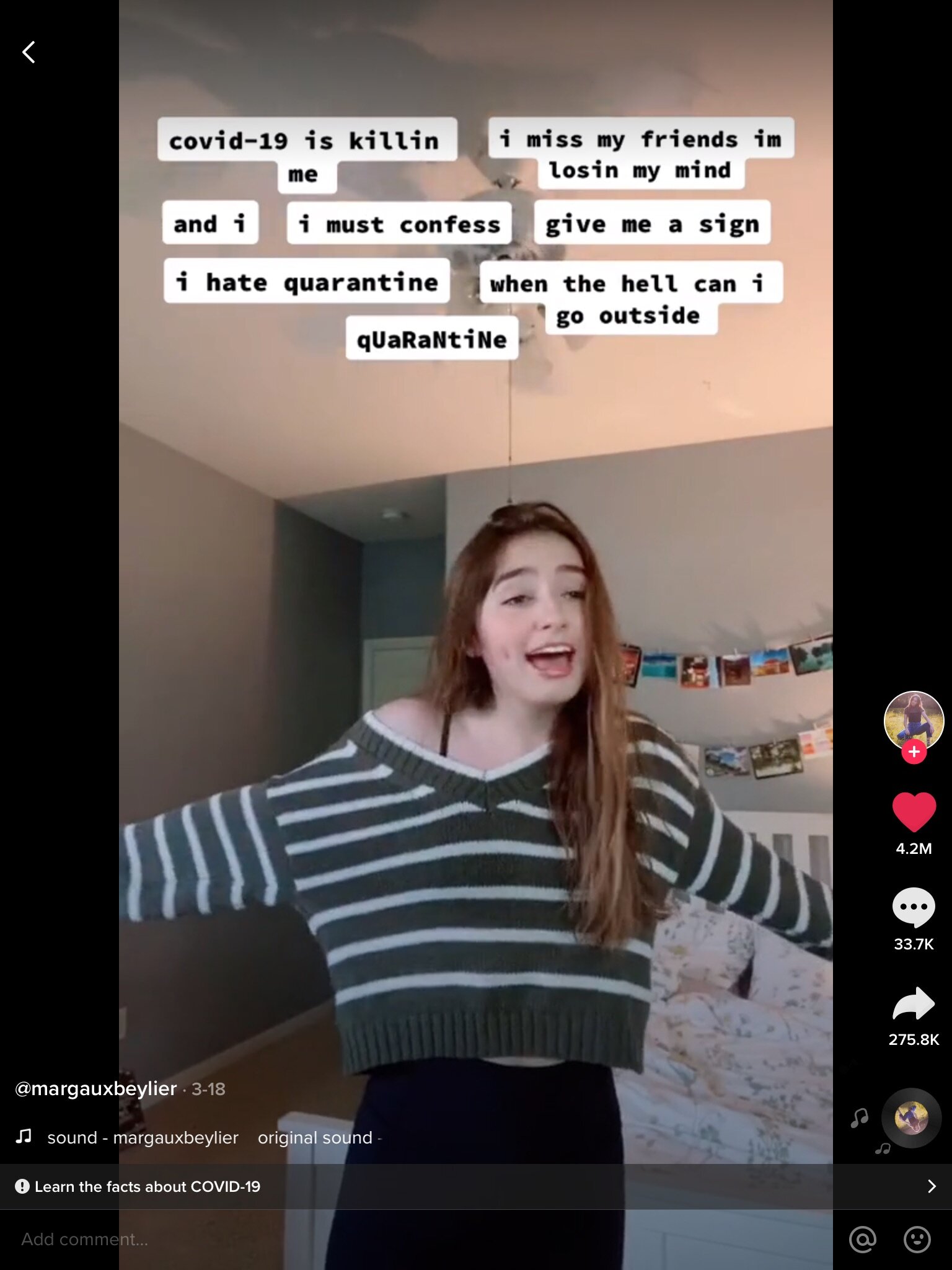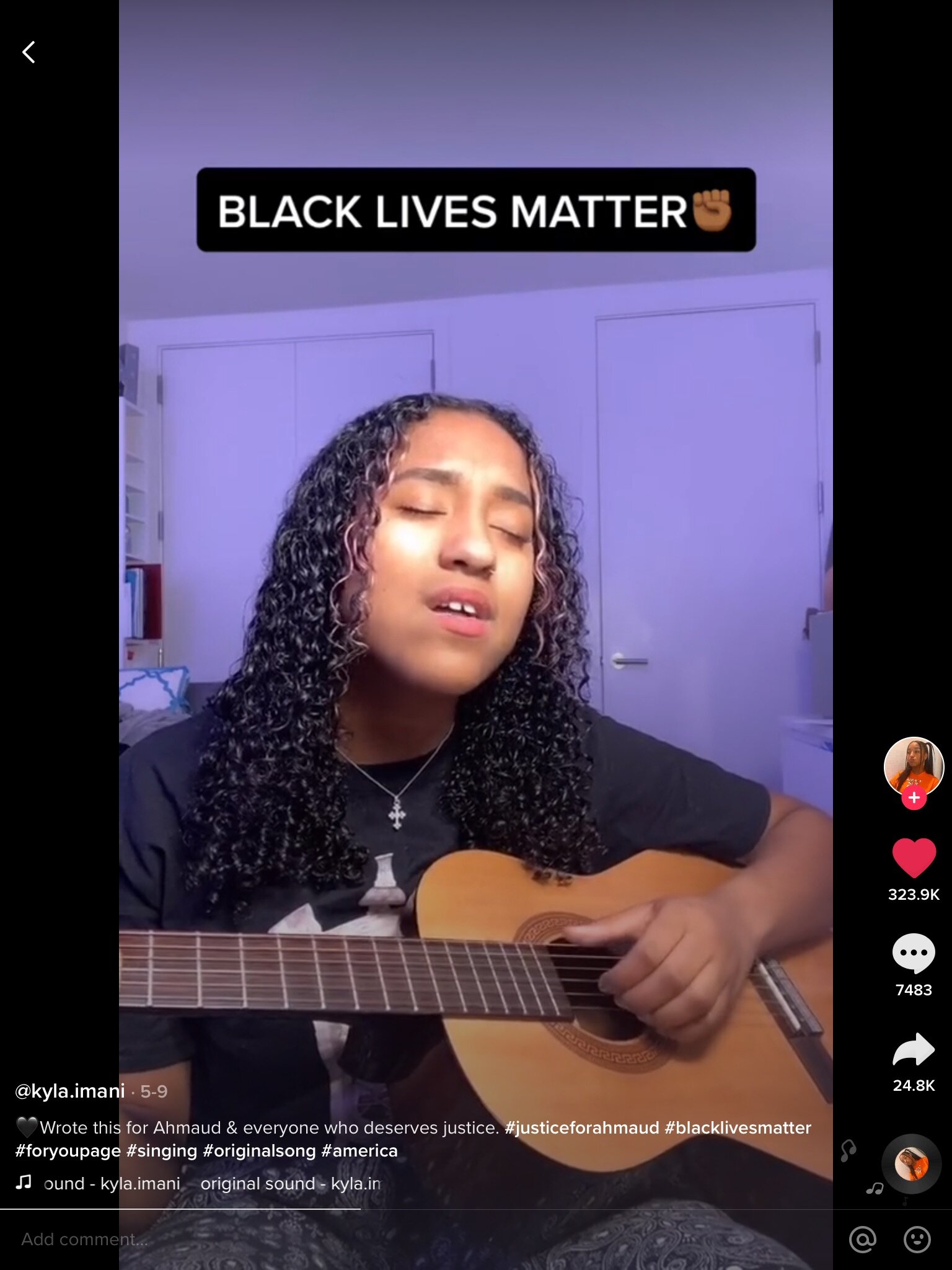TikTok, Teenagers & Crises: Examining Musical Responses to Crises on Tiktok and Implications for Secondary Music Educators
INTRODUCTION
Introduction to the Project
The purpose of this project was to use TikTok users as a sample to study how teens and young adults are using music to cope with the crises of early 2020, including the Covid-19 pandemic and Black Lives Matter protests. Using those observations, lesson plans were developed to support processing and response to crises in future or current circumstances.
Introduction to TikTok
TikTok is a video-sharing app that defines themselves as “the leading destination for short-form mobile video.”*. TikTok videos are 15-60 seconds long and often are set to music available for use or user-created sounds. Users have considerable sound and film editing capabilities through the app, and videos range from completely candid and unedited to highly produced, scripted skits and/or 20+ hours of visual editing. The app is available in 40 languages and currently has 800 million monthly users** and 1,65 billion total downloads ***. It is the direct descendent of 2014’s hit app Musical.ly, and is owned by Beijing-based company ByteDance.
50% of users are between 16-24 years old**** and so the content is both produced and consumed by a significant demographic of younger users. The site currently has no official age restrictions in place but recommends the app for users 13 and older, although many users appear to be younger or appear in their parents accounts. The recommendations in this project are intended for teachers of students in high school.
*https://www.tiktok.com/about?lang=en
**https://datareportal.com/reports/digital-2020-global-digital-overview
***https://sensortower.com/blog/tiktok-downloads-1-5-billion
****https://digiday.com/media/seventeen-hearst-brings-cosmopolitan-musical-ly/
User @makeshift.macaroni expresses the frustration of online teaching via musical performance.
Process & Problems
The TikTok algorithm for video appearances is a closely kept secret. What we do know is that each user experiences a personalized set of recommended videos on their “For You Page”. Users can also choose to “follow” other user accounts, and those are available under the “Following” page on your account. Regarding the algorithm of how videos gain popularity, Matt Schlict says:
“Everyone is now a content creator. Everyone can go viral on TikTok — it’s a level playing ground (vs algorithms on other social networks).”*
That being said, in order to more efficiently collect data, I consciously searched, liked, and saved videos with trending hashtags related to the crises of 2020 including but not limited to: #blacklivesmatter, #blm, #corona, #coronavirus, #covid19, #pandemic, #quarantine, & #quaranteen. The trends are not listed in order of popularity because of the issues of representation, but are rather listed as a group of common themes.
*https://medium.com/@mattprd/how-tiktok-is-changing-the-world-and-youre-missing-it-fa283338649a
FINDINGS
@margauxbeylier covers Britney Spears “Hit Me Baby One More Time” with Covid-19 themed-lyrics, demonstrating Music as Performance.
@jacksonbyrd93 demonstrates Music as collaborative partner, learning and playing the melody of popular Twitter songs/sounds along with the original track.
@ggperans displays an early example of Music as example of “vibe”/playlist, playing “Mr. Brightside” by The Killers and explaining the theme/vibe before showing a slideshow of album covers/tracks.
@kyla.imani shares an original song in reaction to the Black Lives Matter movement in May/June 2020
Based on informal interviews with former students and family members, assigning TikTok videos is not recommended. While many students are likely to be users of TikTok, students should not be required to join open, international, social media networks in order to fulfill the course assignment requirements. Often the dynamic of being assigned to create a TikTok video seemed to squash the intrinsic joy of independently creating TikToks. For this reason, our lesson plans suggest asking students to film 15-60 second videos, making it optional and ungraded if students choose to put the video on TikTok.
Music use divided into the following categories:
Music as collaborative partner
Music or sound is used as a collaborative partner in music creation/performance.
Music as example of “vibe”/playlist
Music is used as example of the larger “vibe” of playlists for highly specific emotions or situations.
Music as interior monologue/dialogue
Music serves as non-diegetic representation of interior monologue or dialogue.
Music as performance
Original performance/pre-recorded original performance by user.
Music as speech
Lyrics of music serve as speech for the user in the video.
Music as soundtrack
Music serves as soundtrack to video action, either foreground or background.
Within Music as Performance, videos were classified into the following categories
Original Creation
Parody Creation
Re-creation
Sound Effect Creation
The most popular musical genres represented, in alphabetical order were:
Film/Television music*
Hiphop/rap
Mashups (multiple genres)
Musical Theater
Pop
Singer/songwriter
*It is worth noting that this genre was highly dominated by not only Disney songs, but specifically Disney princess songs with themes of imprisonment, impatience, and oppression.
Other commonly coded themes of interest to music educators included
Boredom
“Candid” versus “Produced” videos
Dark humor and references to death
Explicit language
Extensive Sound/Film Editing
Isolation
Public Service Announcement
BLACK LIVES MATTER
With extremely limited time (this exam was administered on 06.10.2020) I felt I would be remiss not to include the TikTok responses to this crisis, particularly since the crossover of these two crises was a common theme.
Two songs with controversial histories quickly arose as emblematic of the times, usually use as “music as soundtrack” accompanying protest footage or protest-related art.
This is America, Childish Gambino*
Same Love, Macklemore & Ryan Lewis (previously used as an anthem of Pride**)
Music was observed being used in the following categories:
Music as performance (original & parody)
Music as soundtrack
Music as speech
LESSON PLANS
Lesson 1
Re-writing America
Lesson 2
Foley Artists, Found Sounds and Sound Effects
Lesson Plan 3
Curtis Roach- Bored in the House
Lesson Plan 4
DIY Rhythm Section
Lesson Plan 5
Main Character in a Musical
Lesson Plan 6
Incredibly Specific Playlists
Lesson Plan 7
Soundtrack your life/world.













